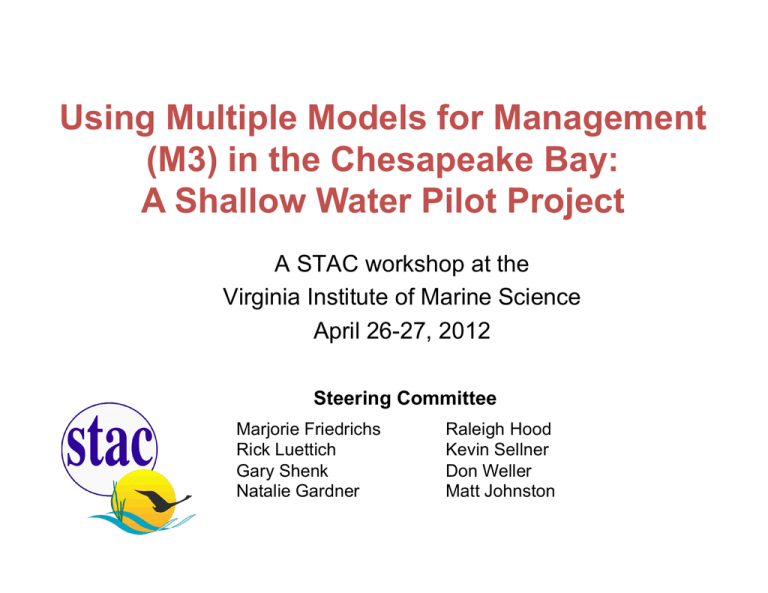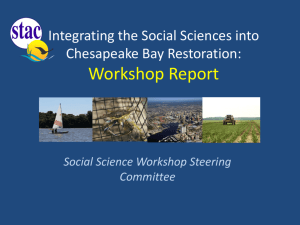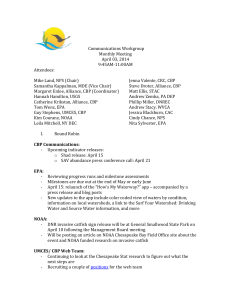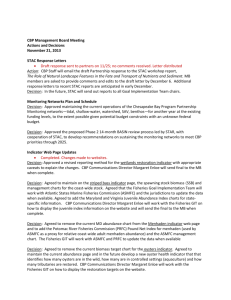Attachment iii - Chesapeake Bay Program
advertisement

Using Multiple Models for Management (M3) in the Chesapeake Bay: A Shallow Water Pilot Project A STAC workshop at the Virginia Institute of Marine Science April 26-27, 2012 Steering Committee Marjorie Friedrichs Rick Luettich Gary Shenk Natalie Gardner Raleigh Hood Kevin Sellner Don Weller Matt Johnston Scientific Assessment of Hypoxia in U.S. Coastal Waters A 2010 report by the: Interagency WG on Harmful Algal Blooms, Hypoxia, & Human Health Joint Subcommittee on Ocean Science and Technology “Use of a multiple model consensus, where models use different approaches and assumptions, provides one way to better inform management decisions. This approach is well known for its application to forecasting hurricane paths and predicting the effects of carbon dioxide fluctuations on climate…” Scientific Assessment of Hypoxia in U.S. Coastal Waters A 2010 report by the: Interagency WG on Harmful Algal Blooms, Hypoxia, & Human Health Joint Subcommittee on Ocean Science and Technology …it is now possible… for several independent or “competing” modeling efforts to address similar issues for the same geographic location. This development is a positive one because scientific debate and consensus building – which promote scientific advancement – cannot occur effectively if there is only a single modeling program.” Would the use of multiple CBP models enhance scientific advancement on Bay issues? Four Reviews/Reports/Letters in 2011 Recommending Use of Multiple CBP Models Ø National Academy of Sciences Review Ø STAC LimnoTech Review Ø STAC Hydrodynamic Modeling Workshop Rep. Ø STAC “Future of Modeling” Letter to MB A Vision for Using Multiple Models in the CBP Modeling Suite (MB meeting Jan 4, 2012) CBP model continue to be used as the sole regulatory model for WQ management decisions with several other community models being used for comparison and R&D. This would: - Demonstrate that the CBP model is equally as skillful as a range of models routinely used by the scientific community - Bolster community-wide (management and academic) support for the TMDL Modeling Framework STAC Management Board presentation, Jan. 4, 2012 STAC Letter: Shallow-water multiple model pilot project (Jan. 2012) • STAC recommends the MB consider directing the CBP to implement a prototype multiple modeling strategy involving both skill assessment and peer review for the identification of models that best match observations in this shallow border of the tidal Chesapeake Bay and its tributaries. • STAC volunteers to assist the effort through the identification of a group of experts to meet with the CBP and identify (1) technical model requirements (2) potential model candidates (3) model inter-comparison requirements needed to ensure adequate skill assessment & peer review. MB Response: Shallow-water multiple model pilot project (Feb. 2012) • “A demonstration project in a well monitored system… would serve as a prototype for the application and assessment of multiple models. The EPA is now examining the potential to fund a few prototype shallow water models this year.” • “To move this forward, …[the MB] would welcome STAC’s assistance in implementing a prototype multiple modeling strategy involving both skill assessment and peer review.” Ø Request for STAC Workshop on Multiple CBP Models Further STAC/MB conversations (Mar 2012) Two goals for workshop on Multiple Models for Management (M3): (1) Define elements that should be included in such a pilot project (2) Discuss benefits and challenges of using multiple models in a regulatory framework STAC decided two separate workshops would be required: M3.1 (April 2012; 25 attendees; Virginia) M3.2 (early 2013; 50-75 attendees; Maryland/D.C.) M3.1 Workshop Agenda VIMS, April 26-27, 2012 Day 1: • Introduction (M. Friedrichs) • Overview of the CBP modeling capacity and future needs (L. Linker) • Challenges for CH3D in the shallow waters of the Bay (C. Cerco) • CB data availability (M. Trice, K. Moore, C. Jones) • Discussion of pilot project details Day 2: • Initial thoughts on M3.2 (benefits/challenges of using M3 in a regulatory framework) M3.1 Workshop Recommendation Ø Overall Recommendation: A shallow water multiple model pilot project is key to the advancement of the CBP modeling program and should begin as soon as possible. Pilot Project Rationale Ø Need for multiple modeling efforts: • Help determine whether the regulatory model is as skillful as other models of the Bay • Build scientist, management and stakeholder confidence in the model at a time when confidence in the regulatory model is low • Excellent opportunity for the CBP to heed recommendations suggested in several recent CBP reports and reviews Pilot Project Rationale (cont.) Ø Need for new shallow water modeling efforts: • Modeling WG has identified limitations to existing model in the shallowest, most productive part of Bay • Because DO & water clarity are criteria that must be met to delist the Bay, the Modeling WG has suggested that additional modeling approaches need to be considered in these waters Pilot Project Outcomes Ø Project Outcome: • Identification of new model for the shallow waters and/or suggested improvements to existing model • Confidence estimates for CBP shallow water simulations • Demonstration of utility of using multiple CB models, in response to recommendations of previous NRC/STAC reports/reviews Pilot Project Methods Ø Methods: • Shallow water hydrodynamic+water quality modelers will be sought for participation in a 1-2 yr pilot project • Each modeling team will: - Use common forcing to implement 3-5 year base case runs at specified times and sites - Provide daily distributions of variables relevant for SAV (T, S, DO, light, nutrients) - Provide results as above after forcing model with specified nutrient reduction scenarios Pilot Project Methods Ø Methods (cont.): • A separate model comparison team will: - Use daily distributions from each model as input to a specified empirical SAV model - Use state-of-the-art metrics to assess the relative skill of the participating simulations - Compare results of the modeled nutrient change scenarios - Analyze causes and impacts of differences among models Pilot Project Funding & Timeline Ø Funding: • ~100K per modeling team per year, depending on # of sites • Significant advantages for a multi-year project • Must have mechanism to ensure participation of governmental research scientists • Cost sharing must not be required Ø Timeline: • Because of upcoming 2015 implementation deadline for the Modeling WG, the pilot project should begin as early in 2013 as possible Pilot Project Site Selection Ø Site Selection Criteria: Most importantly, contrasting, representative sites with data (3-5 years) available: • SAV present vs. absent • Fresh vs. salty • Sandy vs. muddy environment • Tidally vs. wave dominated • Eutrophic vs. oligotrophic Perhaps one Virginia site (e.g. York River) and one Maryland site (e.g. upper Potomac) Note: Workshop SC could provide document outlining specific optimal locations Questions?




